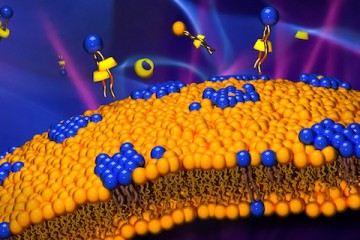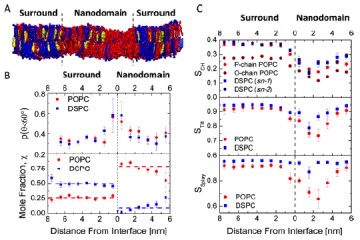Biomembranes
Understanding biological membranes — their structure, dynamic behavior, and function — remains a grand challenge. They are intrinsically multi-molecular and mesoscopic in scale, and their structure and function begin to emerge only with ensembles of hundreds of cooperating molecules, and at length scales greater than about 10 nanometers. Membranes are also heterogeneous and intrinsically disordered two-dimensional systems (Fig. 1). In the transverse dimension, they are compositionally asymmetric, while in the lateral dimension, they are believed to contain nanoscopic domains (“lipid rafts”) critical to their function. In this regard, questions arise about the interplay between lipid rafts and compositional asymmetry, including how asymmetry is maintained, whether rafts bridge the two halves (leaflets) of asymmetric bilayers, and if so, how. A new era in science is emerging that seeks to better understand how nanoscale structure affects biological interactions at the mesoscale. The Biomembranes Program is developing new techniques (molecular dynamics sampling methods, selective deuteration, biochemical assays, proteomics, lipidomics.) and strategies to understand links between physical phenomena (e.g., transverse and lateral structure) within biological membranes, and how membrane homeostasis is affected by the lipidome and proteome.
Figure 1: Cartoon of a cell, or plasma membrane – a selectively semi permeable barrier separating the cell's contents (cytoplasm) from its outside environment. The plasma membrane contains a wide variety of molecules, primarily proteins and lipids, the amounts which differ between species and a cell's function. Protein functions include signaling, cell-cell communication, enzymatic activity, transport, etc. Cell membranes consist of three classes of lipids (i.e. phospholipids, glycolipids and steroids) whose amounts, not unlike proteins, differ depending on cell type. The cytoskeleton is a protein found in all cells which, among other functions, maintains a cell's shape and plays an important role in cell division (Pabst et al. Chem. Phys. Lipids 163, 460 2010).








